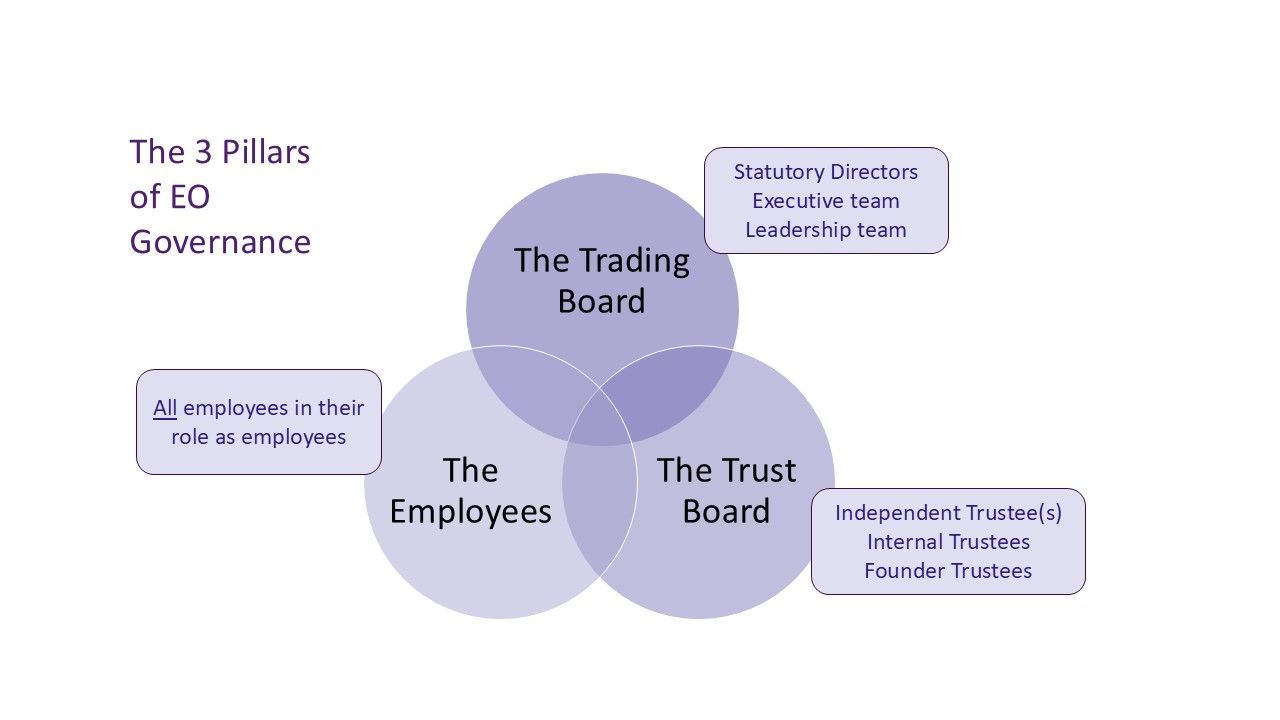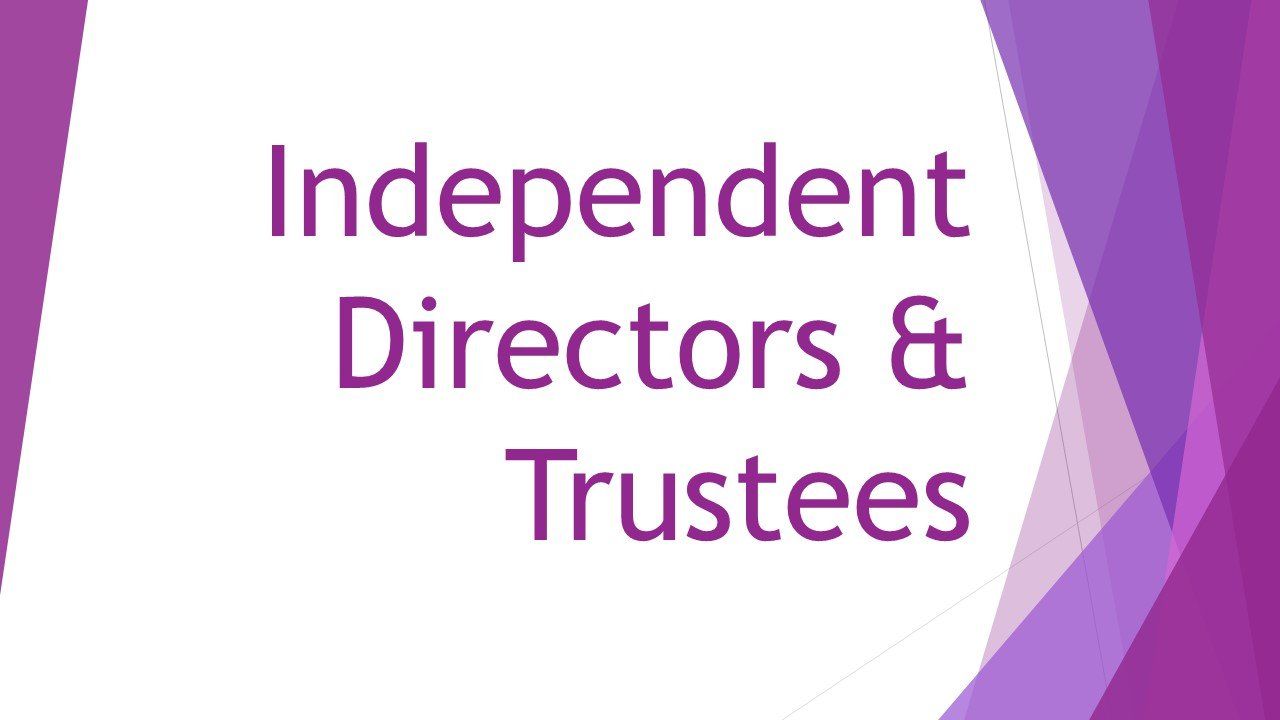EO Explained: The Three Pillars Every Company Should Know
25 September 2025
In the first of a series of articles explaining Employee Ownership (EO) we introduce the concept of the 3 Pillars of EO – the Company Board, the Employees and the Trust as Shareholder.

Understanding this model is key to having a structure that works together, understanding where responsibility and authority lies, without confusion or conflict.
If applied well it is a powerful model that provides clarity aligning the interests of employees with the success of the company, and underpins the future sustainability for the benefit of all.
The Three Pillars of EO
The concept of EO is built on three fundamental pillars: The Company Board, The Trust Board, and The Employees. Each pillar plays a crucial role in ensuring the effective governance, success and sustainability of the company.
1. The Company Board
The Company Board is a critical pillar in the EO model. It is responsible for several key functions that ensure the company's smooth operation and strategic direction. These responsibilities include:
- Setting Strategy: The Company Board is tasked with defining the long-term goals and objectives of the company. This involves setting the strategy, and its components to ensure delivery. Without this element of leadership, the company may struggle to maintain a common sense of purpose, and not benefit form a direction of travel that all employees can understand, be part of and contribute to.
- Managing Risk: Identifying, assessing, and mitigating risks is a crucial function of the Company Board. This ensures that the company is prepared for potential challenges, can mitigate them and can navigate them effectively when they arise.
- Making Critical Decisions: The board is responsible for making significant decisions that impact the company's future. This includes decisions related to investments, mergers, acquisitions, and other major corporate actions aligned to the strategic goals that they have identified.
- Providing Day-to-Day Operational Oversight and Management: While the executive and operational teams handle daily operations, the Company Board provides oversight to ensure that these operations align with the company's strategic goals, comply with any regulatory requirements and fit together.
It should be noted that executive members of the Company Board will have wider responsibilities in relation to their functional role and its delivery. These are actions that are deliverable outside of their role as a board member that, whilst providing individuals’ with deeper insights and knowledge of their specialist topic, do not form a direct part of the boards remit.
2. The Trust Board
The Trust Board plays a vital role in overseeing the company's governance and ensuring that their interests as shareholders, as well as those of the beneficiaries of the trust, are protected. The key responsibilities of the Trust Board include:
- Oversight of the Company and Its Board: The Trust Board monitors the actions and decisions of the Company Board to ensure they are in the best interests of all stakeholders. This includes evaluating the board's effectiveness and holding it accountable, but crucially excludes decision making on behalf of, or direction to, the Company Board.
- Protecting Its Shareholder Interests and Trust Assets: The Trust Board acts as a guardian for the assets of the trust (the Company shares) on behalf of trust beneficiaries, ensuring that their rights and interests are safeguarded. This involves overseeing the distribution of profits and ensuring that the company's actions align with the trust deed and maintaining and protecting the value of the shares.
- Challenging the Future Direction: The Trust Board has the responsibility to question and challenge the strategic direction proposed by the Company Board. This ensures that the company's long-term plans are robust, well-considered and, crucially, delivered.
- Utilising Purpose and Values: The Trust Board should understand the purpose and values of the company as defined by the Company Board, and ensure that these remain core to decision making.
- Encouraging Employee Participation: The Trust Board should encourage the Company Board to understand and welcome employee participation to support their decision making, whilst simultaneously encouraging employees to contribute in a way that is meaningful and beneficial to the success of the business.
In an EO company the trust is a majority shareholder but not always the sole shareholder. Where there is a minority shareholder the alignment between majority and minority shareholders should be clarified in terms of responsibilities, authority, oversight, escalation and involvement.
3. The Employees
Employees are at the heart of the EO model. This pillar emphasizes the importance of employee participation and engagement in the company's success, and the legislative requirement for employees to have a ‘significant and meaningful’ stake in the business. The key aspects are:
- Terms of Employment: All employees act under their terms of employment. This means that their roles, responsibilities, and benefits are clearly defined and aligned with the company's goals and values.
- Beneficiaries under the Trust Deed: Employees are also beneficiaries under the terms of the Trust Deed. This means that they have a stake in the company's success, are entitled to share in the profits and benefits generated by the company made through the contribution that they make as a collective.
- Participation in Decision-Making: Employees are encouraged to provide insights to support decision-making processes. This involvement supports the business and its leadership, ensuring that employees' voices are heard and their contributions are valued. Crucially they are not the decision makers, instead contributing their knowledge through their perspectives in their role.
- Alignment with Company Purpose and Values: The involvement of employees in the EO model ensures that their actions and decisions are aligned with the company's purpose and values. This alignment fosters a sense of ownership and commitment among employees, driving the company's long-term success and sustainability.
Having a forum for employee voice may be beneficial, especially in larger organisations, but is not a requirement of the legislation and, if not implemented well, can become a distraction or negative influence on the business. Meaningful employee contribution is invaluable for leadership decisions and setting the future direction, creating the avenue for this input that aligns to the needs of the business is bespoke to each company and may evolve over time.
The Three Pillars in Action
For the 3 pillars to work in concert, there must be clear and common understanding of the roles, responsibilities and authority of each. Conflict between any two, or all three, of the groups can detract from the purpose of the company, often creating a downwards spiral that drives internal conflict to the detriment of all.
Creating understanding of each works well through workshops and facilitated discussions. Asking questions and setting scenarios for consideration. Ensuring that participants understand both the theoretical concepts, as well as their practical application in their company.
There is often benefit from having combined workshops between groups. Company Board and Trust Board workshops are particularly beneficial both early on in EO, but also as refreshers later on in the company’s evolution. This ensures that any potential conflict or misunderstanding between these two forums is aired and resolved to enable each to be effective in their role.
If there is an employee forum or representative group, having its members workshop all three roles can be beneficial in their understanding and creating ways for their contributions to move beyond social, wellbeing and benefits (tea and toilets) into business beneficial contributions.
Conclusion
The three pillars of EO—The Company Board, The Trust Board, and The Employees—are essential components that ensure the success and sustainability of the company. By understanding, embracing and communicating these pillars, companies can create a more inclusive and engaged workforce, ultimately driving long-term success.
IDT can facilitate workshops of the 3 pillars for EO companies. If you are interested in finding out more contact us at info@directorsandtrustees.co.uk

